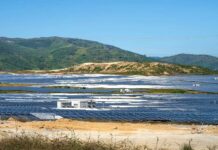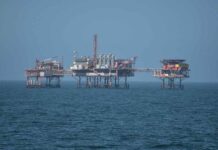PORTAFERRY, Northern Ireland — A black-and-red tower with what look like white wings juts out of the water in Strangford Lough, a fjord that runs from the Irish Sea deep into the farm country of Northern Ireland.
Curious seals stick their heads up as a boat draws close, but they don’t seem to be bothered by the strange-looking device, which is actually a windmill, except its blades are under water.
SeaGen, as the machine is called, might be the most convincing evidence available that the large-scale harnessing of tidal power is becoming more than just an engineer’s fantasy.
Since 2008, SeaGen has been fixed to the sea bottom about 80 feet below the surface in a narrow channel where the tides race in and out of the 18-mile-long Strangford Lough. The fast-moving currents spin the machine’s twin propellers. When they are operating, lowered into the water along the shaft of the tower, they generate enough electricity to power more than 1,000 homes, producing an estimated 3,000 pounds, or $5,000, per day in revenue.
With the wind and solar energy industries well advanced, the oceans are looking more attractive as a new source of clean energy to help reduce carbon dioxide emissions. There are obvious pluses: The tides, especially along the coasts of some countries, including Britain, are powerful and more predictable than wind.
“The ocean is the largest untapped source of renewable energy this planet has,” said Dan Heller, vice president for new ventures at Lockheed Martin, where there has been growing interest in marine energy. Lockheed is best known as an American defense contractor, but also has a hand in civilian projects. The company says alternative energy fits well with its expertise in security and project management.
But harnessing the ebbs and flows is difficult and expensive because the currents play havoc with equipment. Installing SeaGen was harder than expected, and a rotor broke in its early days.
The machine cost £3 million to make and an additional £6 million to install. “It was quite a risky piece of engineering,” said Peter Fraenkel, co-founder of Marine Current Turbines, the company that developed SeaGen. “We were out on our own exploring new territory.”
There can be other complications. When SeaGen is operating, researchers monitor a sonar screen around the clock from a building in Portaferry, on the shores of Strangford Lough. If a blip representing a seal or other marine mammal comes too close to the turbine, the person watching quickly shuts down the propellers. In the summer, seals and porpoises make close passes several times a day, said Andrew Murray of SMRU Marine, which has a contract for safeguarding the animals.
But some environmental groups aren’t too worried that placing dozens of these turbines on the sea bottom might have a negative effect on marine life. “If we want to fuel the world, it is not a zero-impact thing,” said Stephan Singer, director of global energy policy at WWF International in Brussels. “Everything has an impact.”
Marine Current Turbines, a small company based in Bristol, England, sold out to Siemens, the German industrial giant, in 2012. Siemens has the global reach and financial power needed for the next phase, which will cost tens of millions of dollars or more. In Bristol, Siemens is working on turbines almost double the size of SeaGen that the company plans to install in a group of five off the Welsh coast.
Achim Woerner, the head of Siemens’s marine energy business, said potential customers like utility companies want to see a group of machines running smoothly before they buy. “Ocean power is 15 years behind offshore wind,” he said in an interview.
Being only that far behind might be encouraging. Over the past three decades, offshore wind has evolved from a fledgling industry to one that is now building installations that cost billions of dollars and are comparable in generating capacity to conventional power stations.
On the other hand, the offshore wind industry is still expensive and dependent on subsidies, leaving it vulnerable to investor skepticism and government cutbacks. SSE, a big British utility, said last week that it was curbing its investment in four large wind projects off Britain because they did not meet its criteria for financial returns.
Although developers say the costs can be brought down sharply, tidal power is even more expensive than offshore wind and so would require even higher subsidies. Britain may be blessed with more than its share of tidal rips, but guarantees that developers will be paid around £300 per megawatt hour — about seven times the current wholesale price for power — are also a big part of its attraction.
Siemens forecasts that tidal power could eventually account for as much as 4 percent of world generating capacity, and Canada, China and France, along with Britain, are encouraging experiments with such energy.
Another company entering the field is the Singapore-based Atlantis Resources, which recently raised about £12 million in an initial public offering on London’s AIM exchange for small companies. The company is headed by Tim Cornelius, an Australian who worked in the offshore oil industry as a diver and operator of underwater robotic vehicles. Backed by Morgan Stanley and with an agreement for technical support from Lockheed, Atlantis is planning a large tidal power complex called MeyGen off Scotland. The company is also getting ready to test a turbine in the waters off China’s Zhejiang Province, which is thought to have major tidal potential.
But so far, the lonely tower in Strangford Lough might be the only one of these machines generating income.
































